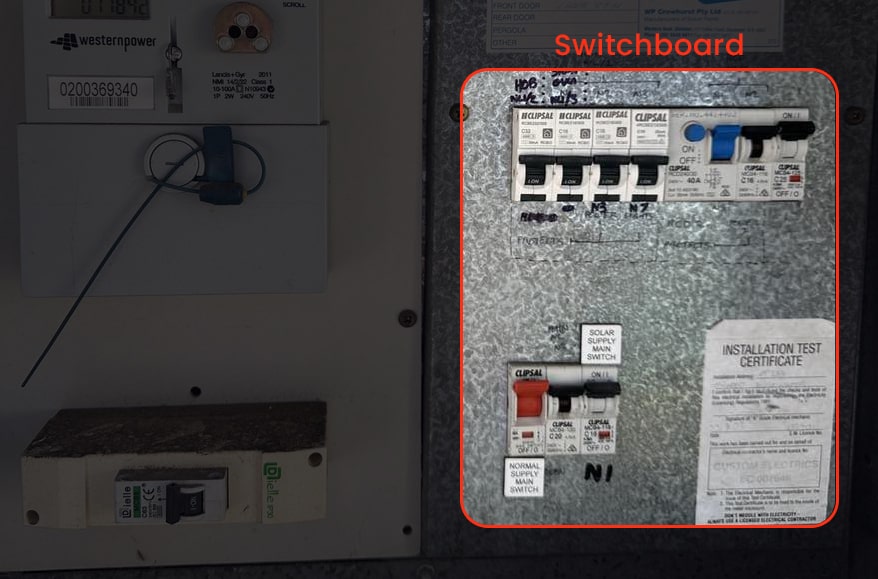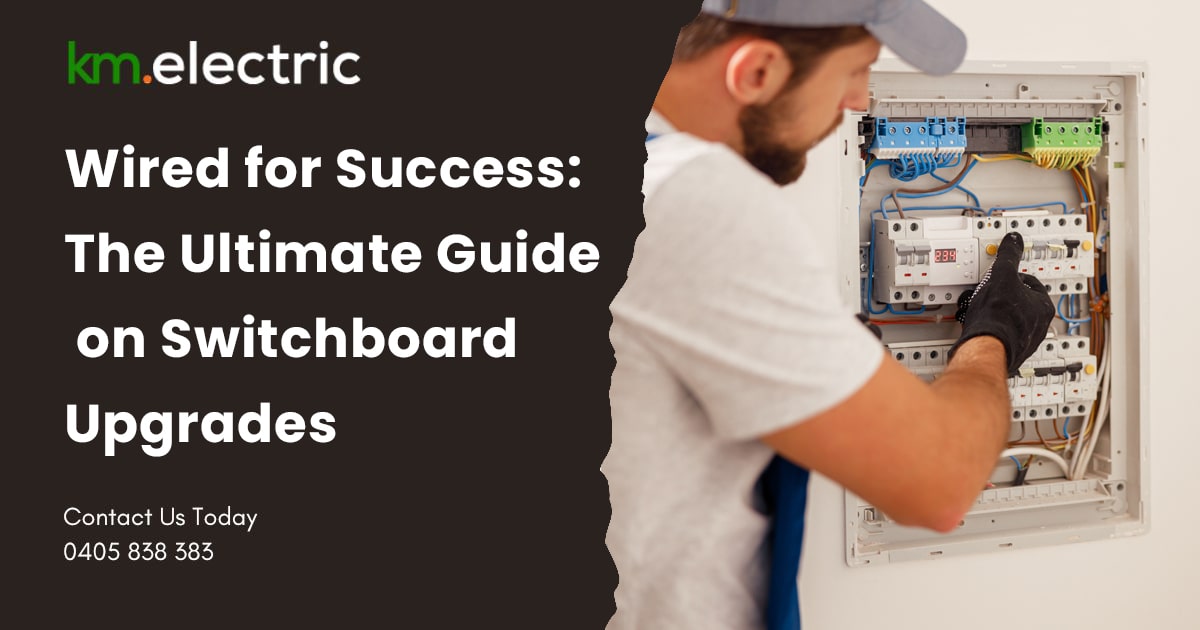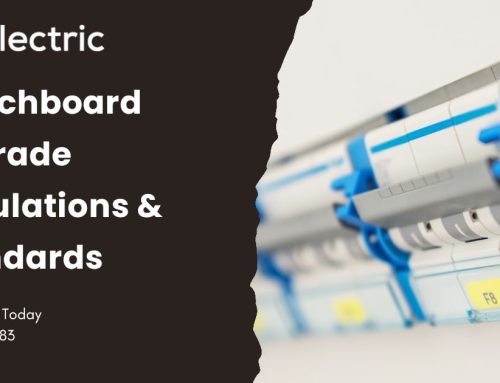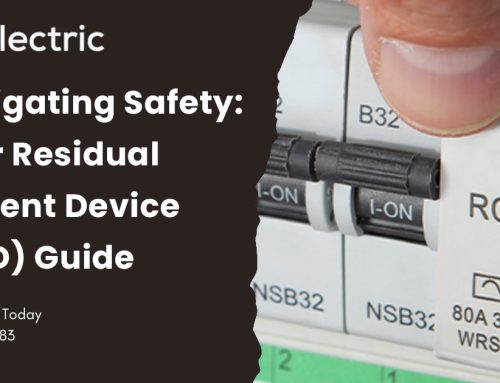While it may seem like a nondescript metal box on your wall, an outdated switchboard can pose serious risks, compromising electrical safety and efficiency.
In both homes and businesses, the growing reliance on electronic devices and evolving electrical codes necessitate regular upgrades. But if you’re unsure if you’re due for a switchboard upgrade in Sydney (or wherever you’re located), this comprehensive guide can help.
In this blog post, we’ll delve into this often overlooked but critical component of electrical systems. We’ll explore the indicators that signal the urgency for a switchboard upgrade, from tripping circuit breakers to insufficient power supply.
We will also share some practical insights, expert advice, and the compelling reasons why investing in a modern switchboard is not just a choice but a necessity for a safer and more resilient electrical infrastructure in your property.
What Is an Electrical Switchboard?
An electrical switchboard is the nerve centre of any property’s electrical system, managing the distribution of power to various electrical circuits.
Types of Switchboards
There are two general types of switchboards:
- Residential Switchboards: Designed for the energy needs of homes, incorporating simpler components for standard applications.
- Commercial Switchboards: More complex, catering to higher energy demands of commercial and industrial spaces.
In residential settings, switchboards typically consist of a main switch, circuit breakers, and safety switches. Commercial switchboards, on the other hand, are more intricate, accommodating the higher electrical demands of larger facilities. They often feature multiple distribution boards, each serving specific areas or equipment.
Differentiating between the two, residential switchboards are designed for the modest energy needs of homes, while commercial switchboards handle the complexities of powering extensive machinery and lighting systems in larger structures. Understanding the distinctions is crucial, as the electrical requirements and potential risks vastly differ between residential and commercial properties.
The Importance of Switchboard Upgrades
The significance of switchboard upgrades cannot be overstated, particularly in residential settings.
Upgrading your residential switchboard ensures compliance with modern safety standards and codes, reducing the risk of electrical fires and shocks. Beyond safety, upgrades accommodate the escalating demand for power in contemporary homes with the proliferation of electronic devices.
For residential property owners, the benefits include:
- Enhanced electrical capacity
- Reduced tripping incidents
- The ability to integrate new technologies seamlessly
Investing in a modern switchboard guarantees a more robust and efficient electrical system for your home. While commercial properties also benefit from upgrades, the core emphasis here is on residential properties, given the changing and increasing electrical demands in households.

Signs Your Switchboard Needs an Upgrade
Recognising the signs that your switchboard requires an upgrade (or that your system is outdated) is paramount for safety and efficiency.
Ensuring the safety and functionality of your property’s electrical system involves vigilance and understanding the key indicators that signal the need for a switchboard upgrade.
Here are the signs to look out for:
- Frequent Circuit Breaker Tripping: If your circuit breakers trip frequently, it may indicate that the electrical load surpasses the capacity of your current switchboard. This is a clear signal that an upgrade is necessary to meet the heightened power demands of modern living.
- Lights Flickering or Dimming: Dimming or flickering lights are often indicative of electrical issues. It could be a sign that your switchboard is struggling to distribute power evenly. Upgrading to a more robust system ensures a stable power supply, eliminating these disruptions.
- Overheated Switchboard Panels: Feel the temperature of your switchboard panels. If they are consistently warm or hot, it suggests that the system is overworking. An overheated switchboard poses a fire risk, emphasizing the urgency of an upgrade to prevent potential disasters.
- Outdated Ceramic or Porcelain Fuses: A critical aspect often overlooked in switchboards is the age of the switchboard. Older models with ceramic or porcelain fuses are not only outdated but pose serious safety risks. These materials are outdated and incapable of handling contemporary energy demands. The brittle nature of these fuses also increases the risk of electrical failure and fire hazards.
The same signs also apply to outdated switchboards and making a note of these is essential for pre-emptive action.
One additional factor to consider in checking whether you have an outdated switchboard is the absence of safety features like residual current devices (RCDs) and arc fault circuit interrupters (AFCIs).
Regular assessment and recognising these signs prompt timely upgrades, ensuring a secure and reliable electrical infrastructure for your property.
Why Old Fuses Pose a Threat
Upgrading to a contemporary switchboard with circuit breakers and safety switches enhances protection against electrical faults and minimises the risk of fire.
Regular maintenance and inspections are crucial, but when dealing with an aging switchboard, upgrading becomes imperative for the safety of occupants and the longevity of your electrical infrastructure.
Here are some specific reasons why insisting on using your ageing system with old fuses can pose threats to your safety:
- Limited Capacity: Ceramic fuses have limited capacity, unable to accommodate the higher electrical demands of modern households and businesses.
- Brittleness: Over time, these materials become brittle, compromising their ability to function as intended. Brittle fuses increase the risk of electrical arcing and fires.
- Inadequate Safety Features: Old switchboards often lack advanced safety features found in modern systems, such as residual current devices (RCDs) and arc fault circuit interrupters (AFCIs).
- Obsolete Technology: With technological advancements, older switchboards are no longer equipped to handle the sophisticated requirements of contemporary electrical appliances and systems.
- Non-Compliance With Standards: Old switchboards may not adhere to current safety standards, putting your property at risk of electrical hazards.
Knowing these facts and understanding the inherent risks associated with outdated components is crucial. Upgrading to a modern switchboard not only addresses these concerns but also ensures the safety and efficiency of your electrical infrastructure in line with contemporary standards.
When to Upgrade Based on the AS/NZS 3000:2018 Standards
Knowing when to upgrade your switchboard is crucial for maintaining a safe and efficient electrical system. The relevant standard for electrical installations in Australia is AS/NZS 3000:2018, commonly known as the Australian/New Zealand Wiring Rules.
The following are the general conditions that may warrant a switchboard upgrade based on the AS/NZS 3000:2018 standards:
- Age of Installation: Consider a switchboard upgrade after a certain period, typically around 20 years, to align with modern safety standards.
- Changes in Electrical Load: Any significant increase in electrical load, such as if you’ve added new appliances or expanded your property, may necessitate a switchboard upgrade to accommodate the higher demand or electrical load.
- Safety Concerns: Any signs of wear, damage, overheating, or outdated components that compromise the safety of an electrical installation should prompt an immediate upgrade to prevent potential hazards.
- Compliance with Standards: Ensuring the switchboard and associated components comply with the latest edition of the Wiring Rules (AS/NZS 3000) to meet current safety and regulatory requirements.
- Introduction of New Technologies: Upgrading to accommodate new technologies or electrical systems that may not have been present or widespread at the time of the original installation.
- Changes in Building Use: Any modifications in the use of a building, such as converting a residential space into a commercial one or vice versa, may require adjustments to the electrical system, including the switchboard.
It’s crucial to consult with a qualified electrical professional to assess the specific conditions of your installation and ensure compliance with the current standards. Always refer to the latest edition of the Australian/New Zealand Wiring Rules for the most accurate and current information.

The Benefits of Upgrading
Underestimating the significance of your switchboard can lead to potential hazards and operational inefficiencies. Upgrading your switchboard is a non-negotiable investment whether you own residential or commercial property.
Let’s delve into the tangible advantages of getting an upgrade:
- Enhanced Safety: Upgrading introduces modern safety features like residual current devices (RCDs) and arc fault circuit interrupters (AFCIs), designed to minimise the risk of electrical faults and fires.
- Compliance With Modern Standards: Upgrading ensures alignment with the latest Australian/New Zealand Wiring Rules (AS/NZS 3000:2018), keeping your electrical system compliant with contemporary safety standards.
- Increased Electrical Capacity: The proliferation of new electronic devices demands more power. Upgrading your switchboard accommodates increased electrical loads, preventing overloads and circuit tripping.
- Reduced Downtime and Repairs: Old and outdated switchboards are prone to malfunctions. Upgrading minimizes downtime and the need for frequent repairs, ensuring a more reliable electrical infrastructure.
- Integration of New Technologies: Modern switchboards are designed to accommodate the latest technological advancements, allowing seamless integration of smart home or commercial automation systems.
- Improved Energy Efficiency: Upgrading enables a more efficient distribution of power, reducing energy wastage and lowering electricity bills.
- Investment in Longevity: While there is an upfront cost to upgrading, the long-term benefits, including reduced maintenance expenses and enhanced reliability, result in substantial cost savings over time.
- Peace of Mind: Knowing that your switchboard is up-to-date and in line with safety standards provides peace of mind, ensuring the safety of occupants and the property.
Understanding Switchboards
Upgrading your switchboard is not just a matter of technicality; it’s a crucial investment for the safety and efficiency of the electrical system in your property. Understanding their functions is key to appreciating the need for an upgrade:
- Distribution Hub: Switchboards act as centralized distribution hubs, directing electricity to different areas of your property.
- Circuit Control: They house essential components like circuit breakers and safety switches, ensuring controlled and safe electricity flow.
- Overload Protection: Switchboards prevent overloads by tripping circuits, safeguarding your property from electrical hazards.

Components of a Switchboard
Knowing the components of a switchboard is fundamental in grasping its importance. Let’s break down the key elements:
- Frame: The metal housing containing the rest of the switchboard components.
- Enclosures: These are the individual boxes that house specific groups of components.
- Main Switch: Serves as the primary control to disconnect power supply to the entire property.
- Circuit Breakers: Individual switches for different circuits, cutting power in case of overloads or faults.
- Safety Switches or Residual Current Devices (RCDs): Rapidly disconnect power in case of a leakage or fault, preventing electric shocks.
- Busbars: Conductive metal strips distributing electricity to various circuits.
- Neutral Bar: Separates the neutral conductors of different circuits.
- Earthing Bar: Ensures a safe path for electric currents in the event of a fault.
- Exterior Covers: These are the external covers protecting the switchboard from the elements.
Safety Standards and Regulations
Understanding the applicable safety standards ensures your switchboard meets the benchmarks for safety and functionality.
- AS/NZS 3000:2018: As discussed above, the Australian/New Zealand Wiring Rules outlines the general requirements for electrical installations.
- AS/NZS 3019:2022 (supersedes AS/NZS 3019:2007): This standard covers the need for the “periodic assessment of existing electrical installations which are connected to a low voltage a.c. supply system (exceeding 50 V a.c. but not exceeding 1 000 V a.c.).”
➜ For more info, please also see our comprehensive guide on Switchboard Upgrade Regulations
Key Considerations for Your Switchboard Upgrade
Embarking on a switchboard upgrade is a decision that requires thoughtful consideration. Here are key the factors to keep in mind:
- Age of the Switchboard: If it’s been over two decades since your last upgrade, it’s likely time for a new one.
- Safety Standards: Ensure compliance with the latest Australian/New Zealand Wiring Rules (AS/NZS 3000:2018) for the utmost safety.
- Future-Proofing: Anticipate future electrical needs to avoid the need for frequent upgrades.
- Technological Integration: Consider the compatibility of your switchboard with emerging technologies for a future-ready electrical system.
Planning for an Upgrade
If you’re planning for a switchboard upgrade, make sure you follow these key steps.
Hiring a Professional Electrician
When it comes to switchboard upgrades, a professional touch is non-negotiable. After all, the efficiency, safety, and longevity of your switchboard will depend on whether you hire a professional, experienced, and trustworthy electrician or company to do the job.
- Ensure the residential electrician you hire for the job holds a valid licence, indicating competence and adherence to safety standards.
- Look for a professional with a track record of successful switchboard installations and upgrades.
- Seek recommendations or check for testimonials and reviews to gauge the electrician’s reliability and quality of work.
Assessing Electrical Needs
Understanding your property’s electrical needs is crucial for a tailored switchboard upgrade:
- Load Analysis: Assess the current and future electrical load to determine the appropriate switchboard capacity.
- Technology Integration: Consider the potential incorporation of smart devices or future technological upgrades.
- Zoning: Evaluate if your property requires specialised zones for efficient power distribution.
Budgeting for the Upgrade
Planning financially for a switchboard upgrade is a prudent step to ensure you’re able to prepare for one adequately:
- Cost Estimates: Obtain detailed quotes from electricians, factoring in materials, labour, and any potential unforeseen expenses.
- Long-Term Investment: While upfront costs may vary, view the upgrade as a long-term investment in safety and efficiency.
- Comparative Analysis: Consider multiple quotes to ensure competitive pricing without compromising on quality.
Switchboard Upgrade Process
Embarking on a switchboard upgrade is a systematic process crucial for ensuring a safe and efficient electrical system.
Inspection and Assessment
Begin with a thorough inspection of the existing switchboard to identify deficiencies and safety concerns.
- Visual Inspection: Evaluate the physical condition of the existing switchboard, checking for wear, damage, or signs of overheating.
- Safety Check: Assess the switchboard’s compliance with safety standards, ensuring it meets current regulations.
- Load Analysis: Examine the electrical load to determine if the current switchboard can handle property demands.
Designing the New System
Develop a new system tailored to the property’s electrical needs, considering load requirements, safety standards, and potential future expansions.
- Capacity Planning: Determine the appropriate capacity for the new switchboard based on the assessed electrical load.
- Safety Features: Integrate modern safety features like residual current devices (RCDs) and arc fault circuit interrupters (AFCIs) for enhanced protection.
- Zoning: Design a system that optimally distributes power, incorporating zoning for efficient control.
Installation Process
Execute the installation process meticulously, incorporating modern components and adhering to industry best practices.
- Component Replacement: Remove outdated components and replace them with new, technologically advanced counterparts.
- Wiring Installation: Meticulously install new wiring, ensuring compliance with safety standards and efficient power distribution.
- Connection to the Grid: Connect the upgraded switchboard to the electrical grid, ensuring seamless integration with the external power supply.
Testing and Quality Assurance
Rigorous testing follows installation to validate the functionality and safety of the upgraded switchboard.
- Functionality Testing: Rigorously test each component to verify proper functionality and responsiveness.
- Safety Checks: Conduct comprehensive safety checks, ensuring all safety features are operational to prevent electrical hazards.
- Quality Assurance: Implement thorough quality assurance measures to confirm that the upgraded switchboard meets industry standards and regulations.
Types of Upgrades
Not all switchboard upgrades are the same. Different properties have unique electrical needs, prompting various types of upgrades. Here’s a breakdown of the common types and their specific purposes:
Capacity Upgrade
A capacity is meant to increase the electrical capacity of the switchboard to handle higher loads.
- Meets the growing demand for electricity in properties with additional appliances or expanded operations.
- Prevents overloads and circuit tripping by ensuring the switchboard can accommodate an increase in power requirements.
3-Phase Switchboard Upgrade
Transitioning from a single-phase to a three-phase electrical system necessitates this type of upgrade.
- Essential for properties using heavy machinery, industrial equipment, or with extensive electrical needs.
- Enables a more balanced and efficient distribution of power, reducing the risk of overloading.
Safety Upgrade
A safety upgrade enhances the safety features within the switchboard.
- Integrates modern safety components like residual current devices (RCDs) and arc fault circuit interrupters (AFCIs).
- Minimises the risk of electric shocks, fires, and other electrical hazards, ensuring a safer environment.
Technological Upgrade
You should get a technological upgrade to incorporate advanced technologies into the switchboard system.
- Facilitates the integration of smart home or commercial automation systems.
- Adapts the switchboard to technological advancements, ensuring compatibility with emerging devices and applications.
By knowing about these distinct types of upgrades allows property owners to tailor the enhancement to their specific requirements, ensuring a switchboard that not only meets current needs but is also prepared for future developments in electrical usage and technology.
Switchboard Upgrade Cost Considerations
It’s important to familiarise yourself with the factors that influence the cost of switchboard upgrades to have the knowledge needed to make informed decisions.
Factors Influencing Costs
The extent of the upgrade, whether it’s a capacity expansion, safety integration, or a complete technological overhaul, will significantly impact project cost. Also, the quality and type of materials and components used in the upgrade will also affect the overall cost.
Skilled labour can be a significant contributor to the expense, with the complexity of the upgrade affecting the required man-hours.
Budgeting Tips
To help you save on expenses:
- Get multiple quotes
- Prioritise essential upgrades
- Plan for contingencies
Return on Investment
While there is an upfront cost to a switchboard upgrade, consider the long-term savings achieved through reduced maintenance and energy efficiency.
After all, a modern, safe, and efficient electrical system adds value to the property, contributing to its market worth. Additionally, investing in advanced technologies ensures the switchboard remains relevant, providing sustained returns over time.
Potential Challenges and Solutions
Switchboard upgrades, while essential, can present certain challenges. Being aware of common issues and solutions is vital for a smooth process.
Common Issues During Upgrades
- Outdated Wiring: Discovering outdated or deteriorating wiring can extend the upgrade timeline.
- Compatibility Issues: Integrating modern components with existing infrastructure may pose challenges.
- Unforeseen Damage: Uncovering hidden damage during the upgrade can potentially disrupt the process.
Troubleshooting Tips
- Thorough Inspection: A comprehensive initial inspection helps with anticipating and preparing for potential issues.
- Clear Communication: Maintain open communication lines with your electrician to address concerns promptly.
- Flexible Scheduling: Be flexible with timelines by acknowledging that unforeseen challenges may arise at any stage of the project.
How to Deal With Unexpected Complications
- Rely on the expertise of your electrician to navigate unexpected complexities.
- Prepare for potential delays by incorporating buffer time into your schedule.
- Keep a contingency fund ready for unexpected expenses.
By being aware of these challenges property owners are empowered to approach switchboard upgrades with preparedness and confidence.
A proactive mindset and effective communication with your electrical professional are key to overcoming any hurdles that may arise during the upgrade process.
Maintenance Tips for Upgraded Switchboards
Upgrading your switchboard is a significant step, but it’s just the beginning.
Regular maintenance is key to ensuring the continued effectiveness, efficiency, and longevity of your electrical system. Let’s explore the following essential maintenance practices:
Regular Inspections
To ensure your upgraded switchboard is in tip-top shape:
- Conduct routine visual inspections to identify any signs of wear, corrosion, or overheating.
- Have safety features such as residual current devices (RCDs) tested regularly to ensure they respond promptly.
- Confirm that all connections are secure, minimising the risk of loose wiring or components.
Addressing Minor Issues Promptly
When issues arise, it’s critical to make a note of these and to:
- Address minor issues immediately to prevent them from escalating into larger, costlier problems.
- Seek professional help if you notice any changes in or issues with your switchboard, ensuring timely and accurate troubleshooting.
- Encourage your family members or property occupants to report any unusual electrical behaviour or occurrences promptly.
Scheduled Maintenance
The importance of timely check-ups in switchboard maintenance cannot be overstated for the safety of your property.
- Schedule regular maintenance check-ups with a qualified electrician to assess the switchboard’s overall condition.
- Have individual components, such as circuit breakers and safety switches, tested periodically.
- Maintain detailed records of maintenance activities and test results for future reference.
By investing in these practices, you not only maximise the benefits of your switchboard upgrade but also ensure a safe and efficient home electrical infrastructure for the long term.
Additional Factors for a Comprehensive Switchboard Upgrade
When contemplating a switchboard upgrade, it’s not just about the board itself; it involves a holistic approach. Consider these additional factors for a comprehensive electrical enhancement:
Asbestos Panel Replacement
If your property has an older switchboard with asbestos-containing panels, replacing this component is imperative. Asbestos poses severe health risks, so replacing these kinds of panels ensures a safer environment. Also, the removal and replacement of components with asbestos align with current safety regulations and standards.
Consumer Mains Upgrade
Upgrading the consumer mains enhances the overall capacity of your electrical system. A modern mains upgrade also ensures a more efficient and balanced distribution of power, and helps to minimise the risk of overloading, particularly in properties with higher energy demands.
Cable Upgrades
Replacing outdated wiring with modern, more durable alternatives during the upgrade is also important as new cables meet contemporary safety standards, reducing the risk of electrical faults. Moreover, upgraded cables improve overall electrical efficiency, reducing energy wastage.
Integration of Circuit Breakers, Safety Switches, and RCDs
During a switchboard upgrade, integrating modern circuit breakers for individual circuit protection and easier troubleshooting is critical. Safety switches (or RCDs) and arc fault circuit interrupters should also be integrated during the upgrade.
- Safety Switches: Enhance safety by incorporating residual current devices, which rapidly disconnect power in case of a fault.
- Arc Fault Circuit Interrupters: Consider AFCIs for additional protection against electrical fires.
Upgrading the switchboard is an opportune time to address these additional factors, creating a comprehensive solution that optimises safety, efficiency, and compliance. These enhancements collectively contribute to a modern, reliable, and future-ready electrical infrastructure whether you’re the owner of a residential or commercial property.
Get a Switchboard Upgrade With KM.ELECTRIC
If you think your house or residential property is due for a switchboard upgrade, you need to work with a trusted, reliable electrical service company.
For the past two decades (and counting), km.electric has been the go-to provider of a range of electrical services for both residential and commercial property owners.
We’re known for delivering honest, reliable, affordable, and fast electrical solutions to the Sydney neighbourhood. Get your free quote and become one of our satisfied customers today!






